Along with DPAA missions, in Italy and Saipan, I have led a number of WWII conflict heritage projects in Saipan. These projects were funded with the help of several grant agencies including National Park Service’s American Battlefield Protection Program (NPS ABPP). NPS’s National Center for Preservation Technology and Training (NCPTT), and the National Oceanic and Atmospheric Administration (NOAA)
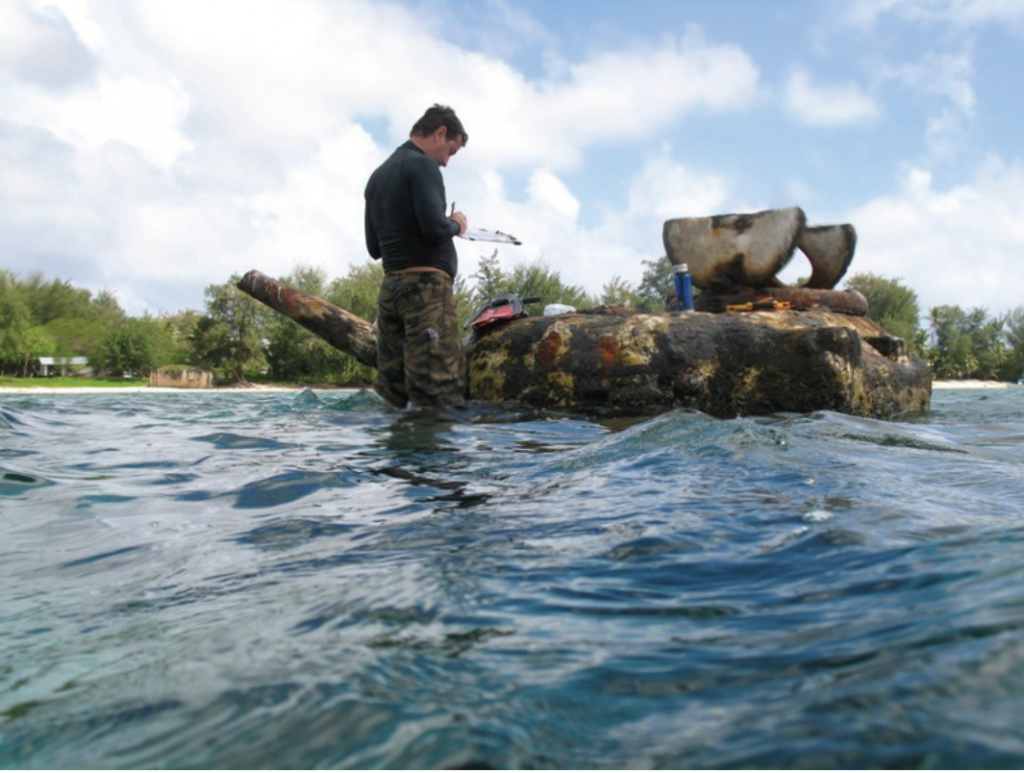
WWII Underwater Heritage Trail Project (2009-2010)
In 2007, the Commonwealth of the Northern Mariana Islands Historic Preservation Office (CNMIHPO) was interested in developing an underwater program. An underwater trail was planned as it would promote tourism, public outreach, education, and preservation of Saipan’s World War II maritime heritage. This project involved intensive field surveys, funded from two ABPP grants, a National Oceanic and Atmospheric Administration‘s (NOAA) Pacific Region Grants Cooperative grant, and a gracious amount of in-kind support and funding.
More information can be found by visiting Pacific Maritime Heritage Trail Saipan.
Management, Monitoring and Interpretive Approaches for WWII Submerged Resources in Saipan (2011-2012)
Due to the importance of the submerged shipwrecks and aircraft wrecks to WWII history and tourism in Saipan, management plans are needed for the preservation of these sites. A team of researchers, including specialists from the Western Australian Maritime Museum, conducted conservation surveys on the wrecks (known as “in situ conservation”). The primary focus was understanding on-site corrosion. Five years later we returned during Operation FORAGER to conduct follow-up surveys in 2017.
For more information, visit the page on In Situ Conservation Surveys.

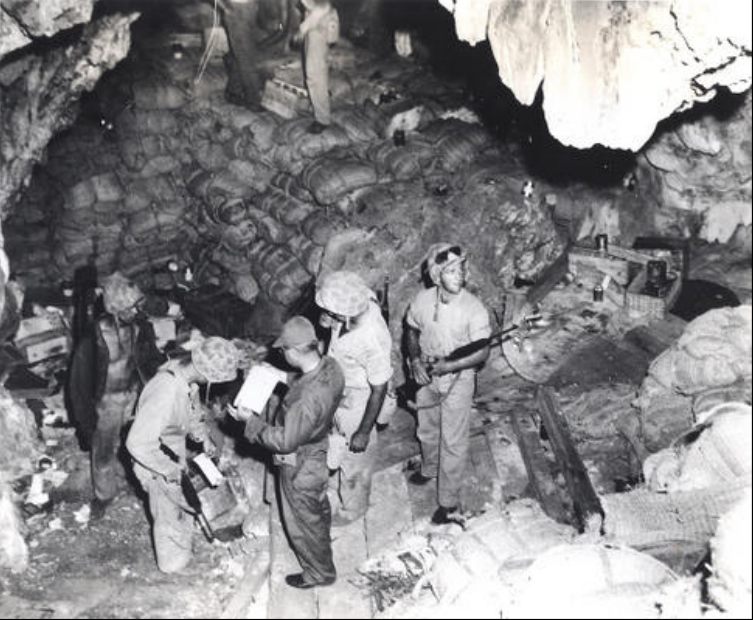
WWII-Related Cave Project (2012-2013)
During WWII, caves served as a place for shelter and protection for the civilians of Saipan. To help preserve this important part of local history our team of researchers from Ships of Exploration and Discovery Research, Inc. and Flinders University worked with the community through public consultations and public meetings to develop a planning document for preservation. We also produced public service announcements.
To learn more, visit WWII-Related Cave Project.
Operation FORAGER: Expanding Documentation and Research of WWII Maritime Heritage (2016-2017)
In 2017, I led Operation FORAGER which investigated the underwater portions of the battlefield on Saipan using a new technology, known as photogrammetry. This allowed us to create 3D models that can be used to analyze the degradation of sites. These models can be found on the WWII 3D Models page. We also conducted a second round of in situ corrosion surveys and surveyed Tinian’s invasion beaches, Unai Babui (White Beach) and Unai Chulu (White Beach 2). The survey produced several anomalies which were investigated as a part of Operation FORAGER.
For more details, visit Operation Forager: Expanding Documentation and Research of WWII Maritime Heritage.
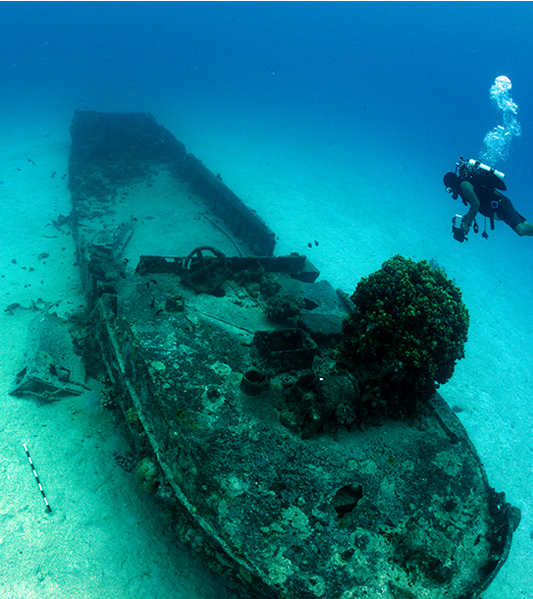
National Register Nomination of a WWII Underwater Battlefield: Battle for Saipan (2017-2020)
All of the work on the underwater battlefield and the development of the heritage trail culminated into a project focused on the nomination of sites to the National Register of Historic Places. Very few underwater sites are on the National Register for the Mariana Islands. As such, this project will place the largest amount of sites on the Register. This effort focuses primarily on the submerged parts of the battlefield that have not yet been nominated.
To learn about this nomination, visit 2017 National Register Nomination.
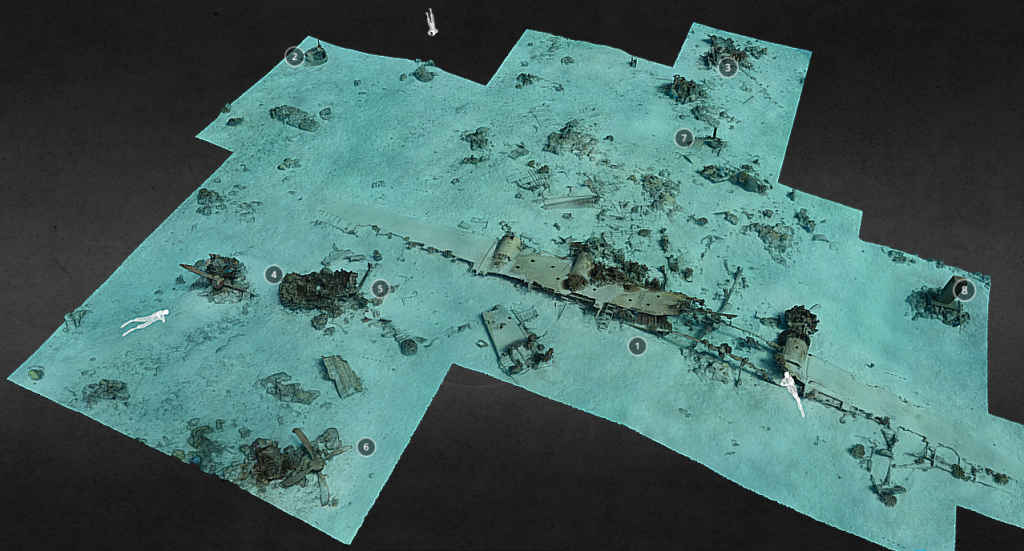
Peleliu’s Forgotten WWII Battlefield (2017-2020)
Operation STALEMATE II, the battle to capture Peleliu, was one of the bloodiest and deadliest in the Pacific Theater. Little research, however, has been paid to the invasion beaches and the amphibious invasion undertaken by U.S. forces. Drs. Toni Carrell and myself launched the 2017-2019 Peleliu’s Forgotten WWII Battlefield project, which was funded by a NOAA Ocean Exploration grant. With fieldwork conducted in 2018, the project was the first of its kind in Peleliu to explore the battle’s amphibious landing area as well as the first archaeological remote sensing survey and 3D biological characterization of the reef environments. Data collected during the project will be used for archaeological interpretation and biological characterization to understand the condition of sites for long-term management and protection. Graduate student Mark Keusenkothen is currently conducting his thesis research on this topic.
Visit the project web page to view more information.
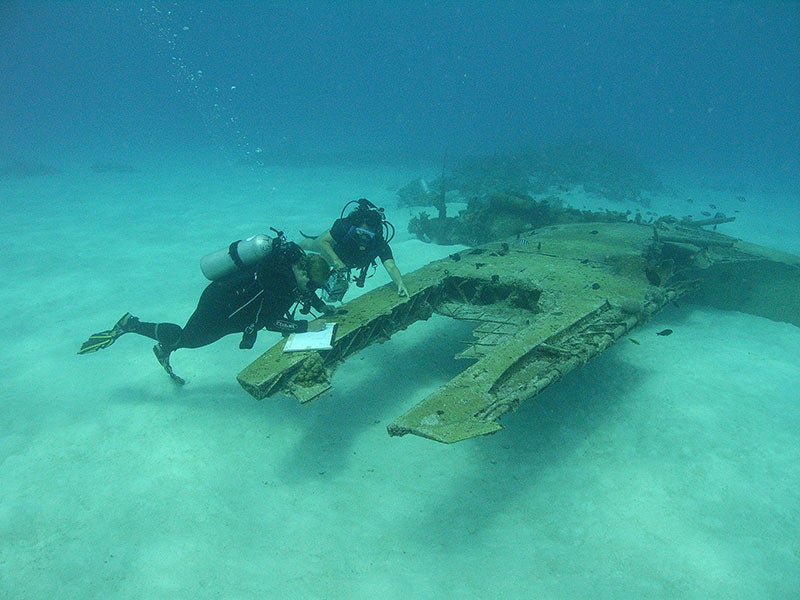
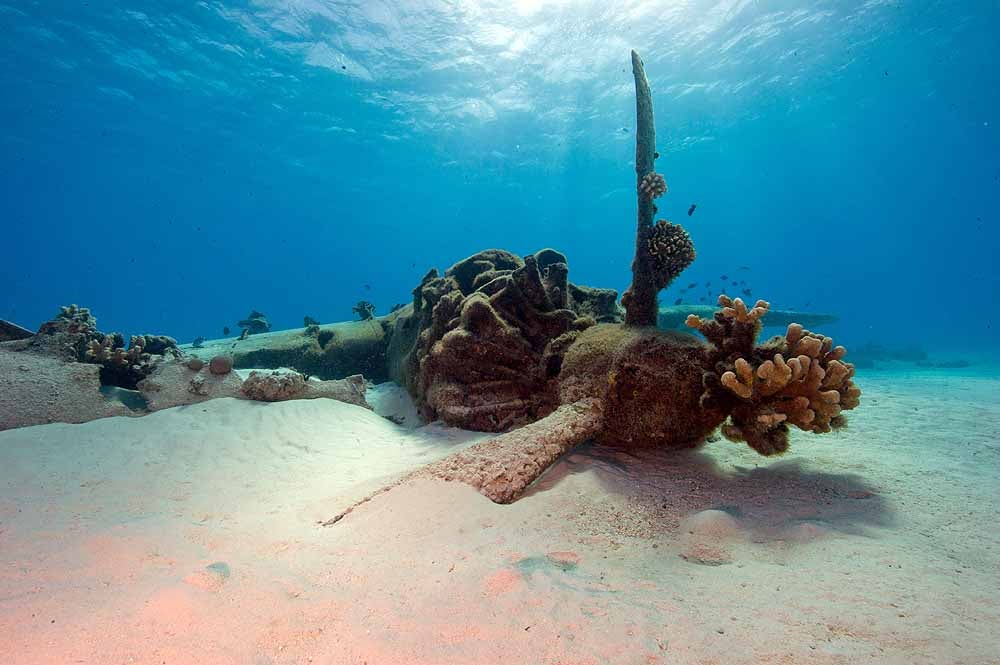
Microbially Influence Corrosion of WWII Aluminum Aircraft Wrecks in Saipan (2019-2020)
Aircraft were a major component of the U.S. war effort in the Pacific Theatre of WWII, and today numerous examples can be found around Saipan. Today, the marine environment poses the largest risk to these sites in the form of deterioration and corrosion. Marine biological influences are still poorly understood, especially at the level of microbiology. This project proposes an interdisciplinary, public archaeology approach to the collection, identification, and study of microbial communities, with interest in sulfate-reducing bacteria that can lead to corrosion of aluminium submerged in seawater.
This study aims to investigate microbially influenced corrosion on WWII aluminum aircraft in Saipan to better understand their decay trajectories and inform resource managers in their preservation practices. This project is funded by the National Park Service’s National Center for Preservation Technology and Training (NCPTT). Please view the announcement of this grant. PhD student Dominic Bush is currently conducting his dissertation research on this topic.
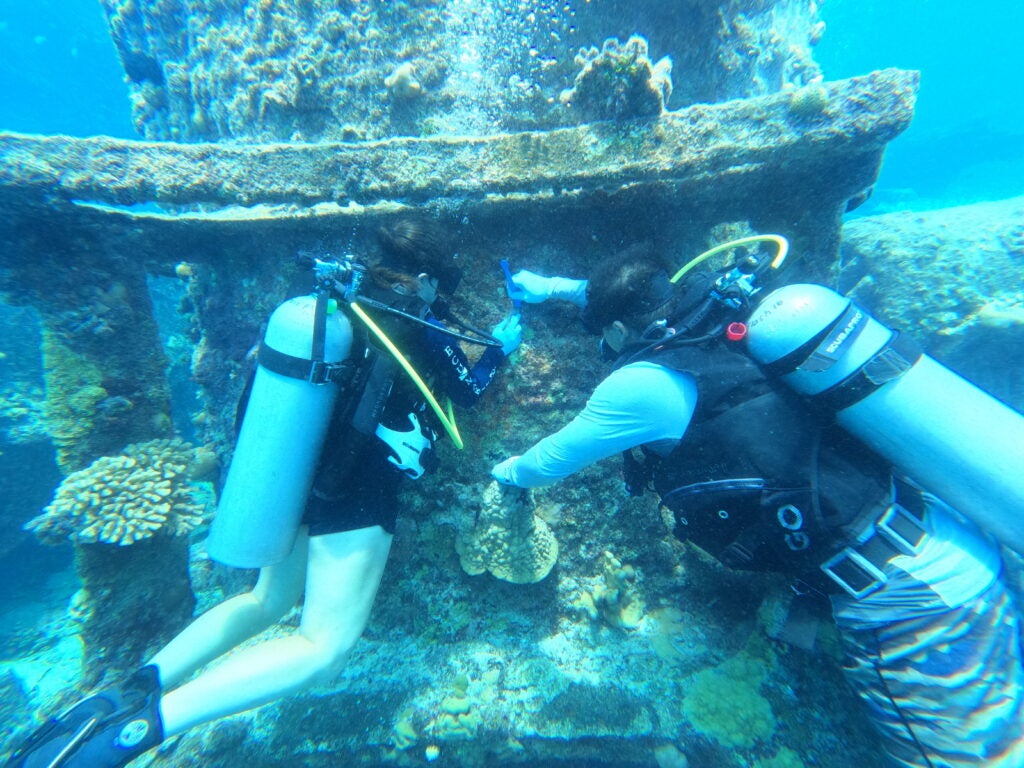
Exploring Deepwater WWII Battlefields in the Pacific Using Emerging Technologies
The battle for Saipan involved thousands of troops from all branches of the military and an imposing number of vessels, vehicles, and weapons. In the lead up to D-Day, 15 June 1944, U.S. fleet commanders conducted staging operations approximately 1000 yards off the western coast of Saipan. These operations included battleships, cruisers, destroyers, carriers, support craft, amphibious vehicles, and the very first offshore seadrome in the Pacific war. This seadrome was where spotter planes launched and spotted the Imperial Japanese Navy fleet leading to the infamous and decisive Battle of the Philippine Sea. The battle marked the end of the drive through the Western Pacific allowing U.S. access to mainland Japan via long-range bombers which facilitated the end of the war. This project sought to explore, locate, and characterize the underwater cultural heritage (UCH) of the offshore battlefield including the first Pacific war seadrome, invasion staging area, and potential environmental hazards from post-war dumping.
This project included: multidisciplinary investigations of WWII UCH; a focus on wrecks as habitat and Blue Economy in regional commercial and recreational fisheries and ecotourism industries; collaboration and engagement with Pacific Islander communities and researchers; in situ sample collection and emerging technologies in UCH exploration surveys including AI for Lidar processing, eDNA analysis, ROV photogrammetric modeling, and corrosion studies; exploration for potential WWII-era dumps and contaminants; and partnerships with diverse stakeholders (i.e., veterans groups) and federal and state management agencies (HPO, DPAA, DCRM). Check out six videos about the project.
Conflict Heritage Theses and Dissertations
I have directed and supported several theses and dissertations on conflict heritage from the Civil War to WWII:
- Jeffery Pardee (2010) A Sit Formation Study of a Possible Submarine Chaser in Tanapag Lagoon, Saipan
- Matthew Hanks (2010) Heritage Management Challenges and Resolutions: Monitoring Submerged World War II M4 Sherman Tanks in Saipan, CNMI
- Samantha Bell (2010) I can Ex-Plane: A Study of Site Formation of Submerged Aircraft in Saipan
- William Shawn Arnold (2010) Investigations in invasion innovation the archaeological and historical study of a WWII landing vehicle tracked in Saipan
- Kyle Lent (2012) Comparative Analysis of Monitor Class Vessels: A Sociocultural Study of USS Monitor and HMVS Cerebus (Flinders University)
- James Hunter (2012) Defence, Discard and Australasian Torpedo Boats (1884-1924)
- James Pruitt (2015) PB2Y Coronado Flying Boat Archaeology and Site Formation Studies Tanapag Lagoon, Saipan
- Hannah Piner (2016) The sled, the litter, and the plot: Finding connections between mundane material culture from World War II’s USS North Carolina
- Julie Mushynsky (2017 The Archaeology of WWII Karst Defences in the Pacific
- Dorothy Sprague (2018) Defining B-29 Airscapes in the Archaeological Record as a Predictive Model for Site Location
- Stephanie Soder (2019) The Japanese and U.S. Fought the War, We Ended up Paying the Price”: The Indigenous Experience on Saipan During World War II
- Jo Edney (2018) Lust for rust: Wreck Divers and the Management of Underwater Cultural Heritage
- Hoyt Alexander (2019) Comparative Analysis of Site Formation and Corrosion: Condor and Stormy Petrel Wreck Site
- Samantha Bernard (2020) Life and Times of a Civil War Blockade Runner: An Artifact Biography
- Jack Gus Adamson (2020) The Saipan Seadrome: A Case Study of World War Two Pacific Seadromes, Their Contributions to the War, and How to Interpret Them in the Archaeological Record
- Andi Yoxsimer (2022) AMAKASU MARU NO.1: An Analysis of a Remotely Operated Vehicle Survey on Japanese World War II Shipwrecks in the Pacific
- Mark Keusenkothen (2024) The Geomorphological and Ecological Effects of a World War II Amphibious Landing on a Coral Reef in the Pacific
- Patrick Smith (2024) Never Forgotten: The Badin Bomber of North Carolina
- DJ Schaeffer (2024) The Beaming Sun: The Effectiveness of Imperial Japanese Radar Against United States Aircraft During the Battle for Saipan
- Dominic Bush (2024) Microbiologically-Influenced Corrosion of WWII Aircraft Wrecks in the Pacific: Case studies from Saipan and Maui
- Geoff Anthony (TBD) Five Days in June: The Archaeological and Operational Legacy of the Saipan Open Ocean Seadrome
- Alex Morrow (TBD) A Study of the Applicability of Aircraft Crash Investigation Techniques on Archaeological Examination of Historic Submerged Aircraft
